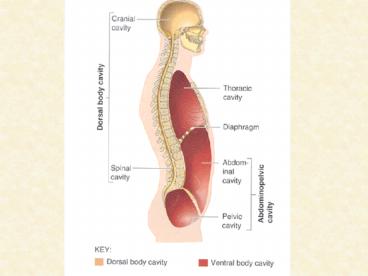Body Cavities - PowerPoint PPT Presentation
1 / 29
Title:
Body Cavities
Description:
Cranial cavity (skull): supports and protects brain ... Serosa: thin membrane that covers the wall ... Embryology: study of developmental changes before birth ... – PowerPoint PPT presentation
Number of Views:248
Avg rating:3.0/5.0
Title: Body Cavities
1
(No Transcript)
2
Body Cavities
- 2 major cavities
- Ventral cavities
- Dorsal cavities
- Other cavities oral, nasal, orbital, middle ear,
synovial
3
Dorsal Cavity
- Posterior region of body
- 2 regions
- Cranial cavity (skull) supports and protects
brain - Vertebral (spinal) Cavity supports and protects
spinal cord
4
Ventral Cavities
- Anterior region of trunk
- Serosa thin membrane that covers the wall of
cavity and outer surface of its organs - Parietal serosa lines cavity wall
- Visceral serosa covers organ
5
Ventral Cavities cont.
- 2 regions
- 1)Thoracic cavity subdivided
- contains lungs, heart, trachea, esophagus,
thymus, lymph nodes - Region between lungs mediastinum
6
Ventral Cavities cont.
- 2 regions
- 2)Abdominopelvic cavity subdivided
- A) Abdominal cavity superior portion of
abdominopelvic cavity - Stomach, intestine, spleen, liver
- B) Pelvic cavityinferior to abdominal cavity
bladder, reproductive organs, rectum - Serosa is called peritoneum
7
Other Cavities (Smaller Cavities)
- Oral teeth tongue
- Nasal within nose left and right side divided
by nasal septum - Orbital contains eyes associated muscles and
nerves - Middle ear contains ossicles (ear bones)
8
(No Transcript)
9
Planes of Section
Transverse Section
Coronal Section
Sagittal Section
10
Transverse Section (Plane)(Cross-Section)
- Runs horizontally at right angle to the vertical
axis - It divides the structure into superior and
inferior regions
11
Sagittal Section (Plane)
- Runs longitudinally (lengthwise) and divides the
body into left and right regions - Midsagittal (median section) cut is made down
the median plane of body and left and right parts
are equal in size
12
Coronal (Frontal) Section (Plane)
- Runs longitudinally but at a right angle to
sagittal plane - It divides the body into anterior and posterior
regions
13
Directional Terms
14
Directional Terms
15
Directional Terms
16
Directional Terms
17
Directional Terms
18
Anatomy
- Study of structure of the body relationship of
its parts - Subdivisions
- Gross Anatomy study of anatomic structures
visible to unaided eye - Descriptive Anatomy study of individual body
parts in an ordered fashion. i.e. nervous system - Regional Anatomy study of limited portions or
region of the body. i.e. head neck region
19
Anatomy Subdivisions cont.
- Applied Anatomy application of anatomic findings
to diagnosis treatment of medical disorders - Comparative Anatomy comparison of the structure
of different animals and plants - Pathologic Anatomy study of abnormal, diseased
or injured tissue
20
Anatomy Subdivisions cont.
- Microanatomy study of anatomic structures using
a microscope - Cytology study of cellular structure
- Molecular biology study of structures at
subcellular level - Histology microscopic study of tissues
21
Anatomy subdivisions cont.
- Developmental Anatomy Study of structural
changes from conception - 2 subdivisions
- Embryology study of developmental changes before
birth - Gerontology study of structural changes that
accompany aging
22
Cell Diversity
23
(No Transcript)
24
(No Transcript)
25
(No Transcript)
26
(No Transcript)
27
(No Transcript)
28
(No Transcript)
29
(No Transcript)































